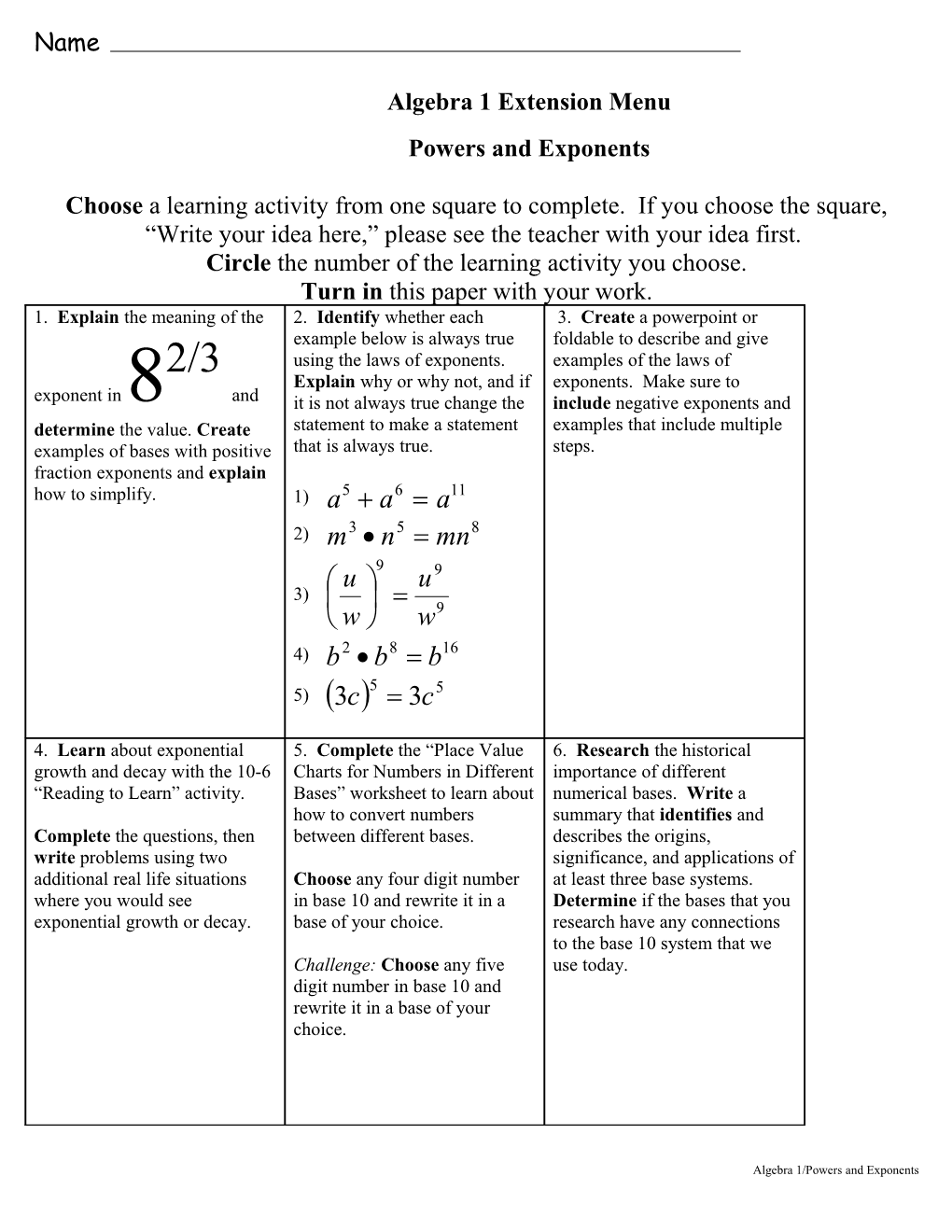Name
Algebra 1 Extension Menu
Powers and Exponents
Choose a learning activity from one square to complete. If you choose the square, “Write your idea here,” please see the teacher with your idea first.
Circle the number of the learning activity you choose.
Turn in this paper with your work.
1. Explain the meaning of the exponent in 82/3 and determine the value. Create examples of bases with positive fraction exponents and explain how to simplify. / 2. Identify whether each example below is always true using the laws of exponents. Explain why or why not, and if it is not always true change the statement to make a statement that is always true.1)
2)
3)
4)
5) / 3. Create a powerpoint or foldable to describe and give examples of the laws of exponents. Make sure to include negative exponents and examples that include multiple steps.
4. Learn about exponential growth and decay with the 10-6 “Reading to Learn” activity.
Complete the questions, then write problems using two additional real life situations where you would see exponential growth or decay. / 5. Complete the “Place Value Charts for Numbers in Different Bases” worksheet to learn about how to convert numbers between different bases.
Choose any four digit number in base 10 and rewrite it in a base of your choice.
Challenge: Choose any five digit number in base 10 and rewrite it in a base of your choice. / 6. Research the historical importance of different numerical bases. Write a summary that identifies and describes the origins, significance, and applications of at least three base systems. Determine if the bases that you research have any connections to the base 10 system that we use today.
Teacher Resource Page
Algebra 1
Extension Menu
Concept and/or Topic: Powers and Exponents
Intended Purpose: Culminating activity for the unit or alternative activity for students who have mastered curricular indicators.
Standards:
ALG.05 Analyze a wide variety of patterns and functional relationships using the language of mathematics and appropriate technology expressed numerically, algebraically, and geometrically.
ALG.10 Model and interpret real-world situations, using the language of mathematics and appropriate technology.
ALG.15 Collect, organize, analyze, and present data.
ALG.20 Apply the basic concepts of statistics and probability to predict possible outcomes of real-world situations 3.2.
Indicators Addressed:
Box 1: Topic extension- fraction exponents
Box 2: Topic covered: Properties of exponents
Box 3: Topic covered: Properties of exponents
Box 4: Topic extension- exponential growth and decay
Box 5: Topic extension- using exponents to write numbers in different bases
Box 6: Topic extension- using exponents to write numbers in different bases
Organizational Tips:
Box 3: Information about foldables can be found in your Glencoe resource kit.
Box 4: Duplicate the 10-6 Reading to Learn handout from your Glencoe Resource kit and make available
for students.
Box 5: Duplicate the handout Place Value Charts for Numbers in Different Bases and make available for
students.
Box 5: The website, http://mathbits.com/mathbits/compsci/Introduction/frombase10.htm, provides an
application on how to convert numbers from base 10 to other bases.
Box 5: The website, http://www.csgnetwork.com/base2baseconv.html, provides a base to base number converter.
Place Value Charts for Numbers in Different Bases
· Base 10
10,000,000 / 1,000,000 / 100,000 / 10,000 / 1000 / 100 / 10 / 1The number means
That means 500+40+6, or 546
· Base 2
The number means
That means 8+0+2+1, or .
· Base 5
The number means
That means 500+50+0+3, or .
To convert a base 10 number to a different base, start with the place value chart. Look for the highest power of the base that can go into your base 10 number.
· Change to base 5.
Base 5
625 / 125 / 25 / 5 / 1x / 3 / 1 / 4 / 3
Algebra 1/Powers and Exponents
